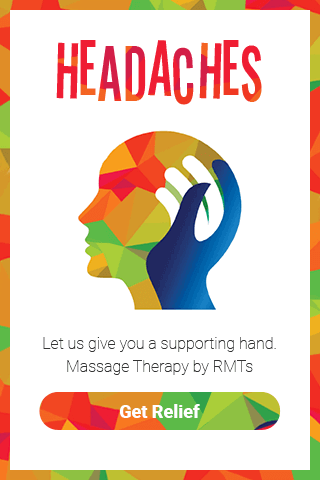Discussion
The results of this study suggest that massage therapy is effective in reducing the number of headaches per week in chronic tension headache sufferers. Compared with baseline levels, headache frequency was reduced within 1 week of massage treatment. This reduction was maintained during the 4 weeks of the treatment period. A trend toward a reduction in the average duration of each headache event between the baseline period and the treatment period was also noted. On the basis of these results, we conclude that pain associated with chronic tension headache can be alleviated through specific massage therapy treatments directed at cranial and cervical muscles.
Active muscle trigger points may be the underlying etiology of many tension headaches. Muscle trigger points have been identified by electromyogram measurements as hyperactive contractile regions of a muscle compared with the surrounding tissue (21). These hyperalgesic regions in skeletal muscle and fascia have been implicated as a cause of regional and referred pain associated with chronic headache (22,23). Furthermore, a connection between tension headache induction and muscle trigger-point activity has been suggested (24). Tension headache, for example, has been experimentally induced by 30 minutes of teeth clenching, which resulted in increased facial tenderness, a characteristic of active trigger points (25). However, literature reports regarding specific treatment of active trigger points for reduction of headache pain have been limited. In a 1996 case study, Dunteman et al. injected anesthetic into active trigger points of the sternocleidomastoid muscle and found a reduction in headache pain that persisted for at least 14 months (26). In the present study, active trigger points were frequently noted, by palpation techniques, in the muscles of subjects. Approximately 6 active trigger points could be massaged during the therapy session within the given time parameters. Because our therapeutic massage protocol specifically addressed trigger-point activity, we believe that the reduction in activity of these regions by massage was a major contributor to the observed beneficial effects on tension headache.
Results of a pharmacological intervention suggest that amitriptyline, a drug commonly used to treat chronic headache, can reduce myofascial tenderness in chronic tension headache sufferers; however, this effect was achieved by reducing nociceptive stimuli rather than reducing trigger-point sensitivity (27). It is interesting to note that in most of our sessions, patients reported a reproduction of their headache pain with deep palpation of identified trigger points, despite not experiencing a headache immediately prior to this palpation. This finding suggests an association between the trigger point and formation of a headache. Further investigation into the relationship between headache and trigger points would prove valuable.
Our massage therapy treatment protocol was successful in reducing pain associated with chronic tension headache. However, we cannot unequivocally state that the massage portion directed at trigger-point therapy rather than the stretching or relaxation techniques was the causative agent. Evidence from the literature shows slight reductions in headache activity after stretching and relaxation (28). Given that these techniques constituted only a small portion of our treatment protocol and that the effects found by other researchers with stretching or relaxation were small, we believe that our massage procedure focusing on trigger-point therapy is effective.
This study was unique in that we used a highly standardized massage treatment protocol, which was practiced and performed by certified massage therapists. Although this design complicates the question of which component of the treatment was most effective, we feel that standardization of treatment is critical for consistency in therapies. Once an effective procedure has been developed, additional aspects of massage can be included and assessed for their therapeutic contribution.
Unfortunately, this study is limited by its extremely small sample size – only 4 subjects completed all massage sessions and all of the daily logbook entries. The low completion rate may have been influenced by the enrollment period of the study, which occurred just before Thanksgiving, and by difficulty in scheduling appointments during the Christmas and New Year’s holidays. The lack of a larger sample of subjects contributed to low statistical power, hindering our ability to show a significant reduction in headache duration and intensity between baseline and treatment phases. However, because headache duration improved in all 4 subjects and headache intensity in 3 subjects, the reduction was probably real.
Our specific massage technique may also benefit headache sufferers during an acute headache episode. On 4 occasions when a subject entered the massage session with a headache, the headache was alleviated by the end of the 30-minute treatment; on no occasion did a subject enter treatment without a headache and leave with one. This suggests that massage administered during a headache episode might result in immediate beneficial effects and that patients should be instructed in appropriate self-massage.
Massage therapy appears to be an effective nonpharmacological treatment for alleviating chronic tension headache. A significant and meaningful reduction in headache frequency and duration was observed in this study even though the number of subjects was small. The findings suggest that a larger, more complete study that includes a proper control group is warranted.
Authors: Christopher Quinn, DC, Clint Chandler, BS, and Albert Moraska, PhD
This article has been cited by other articles in PMC.
